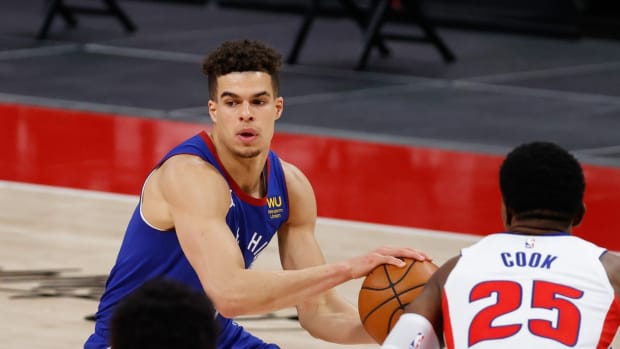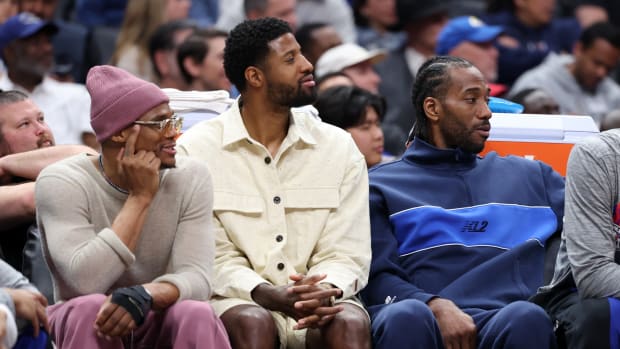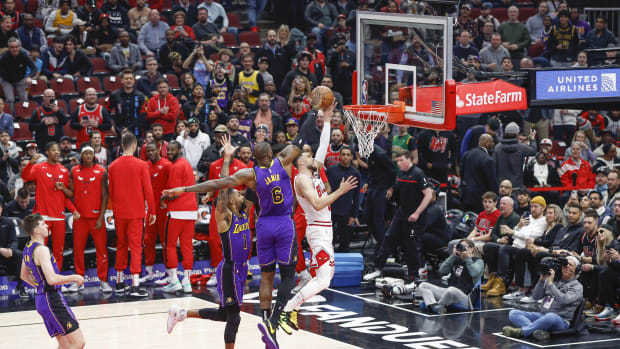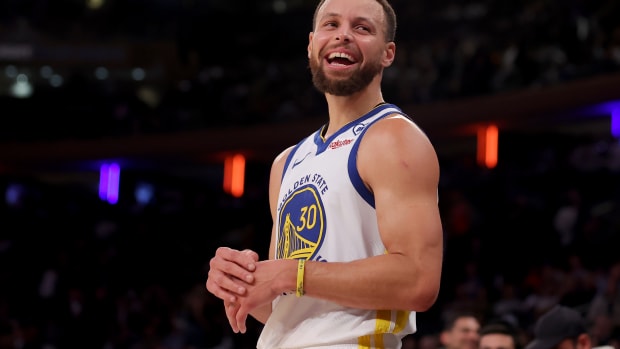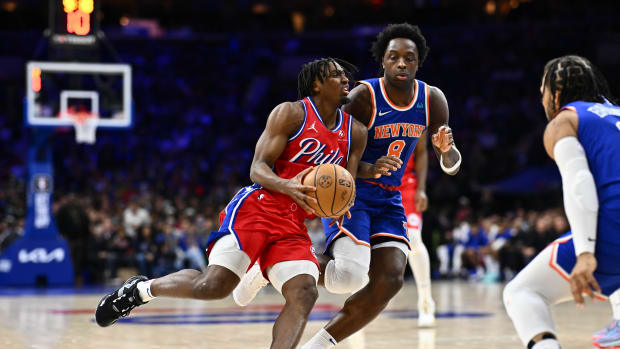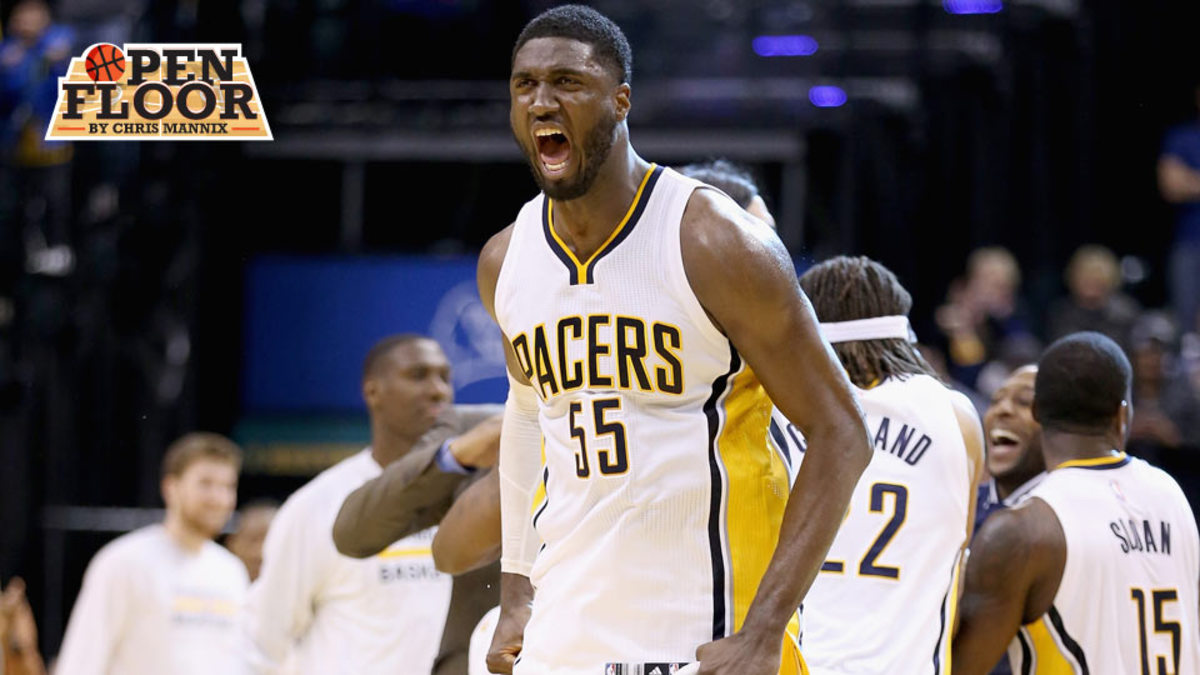
Open Floor: Rebuilding Roy Hibbert, Cavaliers' bad omens and more
When Roy Hibbert went from good to bad to cartoonishly awful last season, Frank Vogel was frequently the only man standing between Hibbert and a media firing squad eager to lampoon the struggling 7-footer. Each time a reporter asked about Hibbert’s offensive output -- which, to be fair, did fall off a cliff in the second half of the season -- Vogel was quick to remind everyone within earshot that Hibbert’s defense had not missed a beat.
“And that’s what we needed from him,” Vogel said. “Look, he wasn’t getting many touches. We know that. He became a defensive center, a Dikembe Mutumbo of sorts. That’s why a lot of the criticism of him was unfair; he was doing what we needed him to do.”
Well, it was sort of fair. Hibbert won’t remind anyone of Ewing or Olajuwon, but in the first half of 2013-14 he was a reliable offensive option, averaging 11.8 points on 46.4 percent shooting before the All-Star break. His ouput plummeted in the second half of the season (8.9 points on an abysmal 39 percent shooting), bottoming out with four scoreless performances in the postseason, his confidence seemingly eroding with every missed shot. Instead of operating instinctively, Hibbert whirred with uncertainty.
Fixing Hibbert -- in the third year of a four-year, $58 million max deal -- was a top priority for Indiana coming into this season. Hibbert did his part over the summer. He transformed his body, lightening his frame from 293 pounds last season to a svelte 278, a weight Hibbert was effective at in 2012. He cut out sugars, loaded up on asparagus and eliminated processed foods. “Brown rice was the hardest thing to give up,” Hibbert said. “Your body just yearns for it.” He stopped late-night snacking. He took up yoga and Pilates and spent more time meditating.
“It wasn’t that hard,” Hibbert said. “I knew I needed to make changes.”
New Year's resolutions for NBA teams: Part I, Eastern Conference squads
As Hibbert worked on his body, he had some help retooling his game. In July, Kareem Abdul-Jabbar -- reinvented as a big man coach for hire -- reached out to the Pacers. He wanted to work with Hibbert. For Hibbert, the workouts with Kareem were less about adding something to his game -- the sky hook won’t be a weapon anytime soon -- but rediscovering the things that were already there.
“Offensively, we talked about taking up space, about getting low and wide in the post,” Hibbert said. “He talked to me about being a menace on defense. He said I needed to talk more. Sometimes I struggle with that. Defensively, I worry about guarding the rim. Talking more helps a lot.”
Said Vogel, “One thing I’ve noticed is that he is maintaining vision of the ball. Before, he would turn and look for a crasher. That was a big reason our guards were among the best rebounders in the NBA, because Roy boxed out. He’s using his arms and body more.”
To help Hibbert, Vogel retooled the playbook. This season, Vogel says, there is a more concentrated effort to look for Hibbert in the post, to reward him for establishing deep position. Vogel has also incorporated sets that feature Hibbert on the perimeter, using him “in the same way Memphis uses Marc Gasol.” Hibbert is a surprisingly solid deep jump shooter, connecting on 49 percent of his long two’s this season, per Synergy Sports. Vogel moves Hibbert around based on who is alongside him; a Hibbert-David West front line usually features Hibbert in the post. A Hibbert-Lavoy Allen combination opens up opportunities to move Hibbert to the perimeter.
“We’re just continuing to make sure he is involved,” Vogel said.
No question, the rehabilitation of Hibbert is still incomplete. Hibbert’s scoring (11.0 points per game) is hovering around the same as last season, as is his field goal percentage (44.4 percent). There have been good games (an 18-point, 11-rebound effort in a win over Charlotte in November) and bad (a zero-point, five-rebound mess against Denver in December) with plenty of solid ones mixed in between. An ankle injury cost Hibbert four games in November and, Hibbert says, impacted his ability to move for a few weeks after. “There have been some ups and downs,” Hibbert said. “But I’m getting there. I’m trying to get myself back to playing at a high level.”
SI's 10 favorite NBA moments of 2014
There is considerably less pressure on Hibbert than there was last season, when Indiana’s second-half slide -- and Hibbert’s noticeable role in it -- drew national attention. The defection of Lance Stephenson to Charlotte and the season-ending injury to Paul George in the offseason transformed the Pacers from a title contender to one struggling to stay in the playoff mix in the weak Eastern Conference.
For Hibbert, his job isn’t to replace George's and Stephenson’s production, but to get back to being the player he was when they were still around.
“I’m not going to be the type who scores 20 points per game,” Hibbert said. “I know that. I know there are people that are expecting me to take over that role, but being realistic, I know who I am. I try to be solid. I try to be effective in the post. And I try to be a good defender and rim protector. That’s what I do.”
Scout's Take: Cavaliers
A Western Conference scout on Cleveland, which has dropped three straight games and will be without LeBron James for possibly the next two weeks.
They have really bad body language right now. Even when they are ahead in games, they just don’t look like they have any passion. Guys go hard, then as soon as an opponent hits back and makes shots, it gets bad. They are just going through the motions, all the way through the lineup. LeBron is casual with the ball, just throwing it all over the place. He’s not engaged during timeouts. It’s just a bad feeling for them.
Offensively they are not really running much of anything. Everyone was anticipating David Blatt running a lot of Princeton, but they have been really simple. It’s just simple NBA stuff. LeBron is willing to hijack the offense when he wants to or when it’s not going the way he wants it to go. There is not a lot of direction. Kevin Love is standing out on the perimeter shooting jumpers; he doesn’t spend a lot of time in the post. They don’t utilize his passing skills. You would think that would be an area he could get something done. He doesn’t look like he is engaged either.
LeBron James-David Blatt feud may be as tense as the media portrays
They don’t have a rim protecter, which has been a major problem. Tristan Thompson is the only guy out there who can block shots. The effort on defense is not there. When LeBron was in Miami, he was all over the floor, running, double teaming. They are a passive defense and there is nothing in the middle to dissuade someone from getting easy shots. Even when [Anderson] Varejao was in there, he wasn’t dissuading them. There is not a collective paint presence.
They show frustration coming out of timeouts. They are not executing. It’s a small sample size so you don’t know what Blatt is as an NBA coach. But scheme-wise they are not doing anything to make up for whatever they lack. There is not a lot of buy-in for what they are trying to do defensively. The roster doesn’t help. In Miami, Erik Spoelstra would double team, would overplay the wings, but he had a more athletic group. Kyrie Irving is solid but he is out there trying to get steals. Waiters is not a defense first guy. In Miami, Mario Chalmers was a defender, Dwyane Wade would at least play with intensity. And when LeBron was out there, it was hard to get the ball into your initial pass to get into the offense. He hasn’t been the same guy in Cleveland.
Next page: Collison's second chance, impact of Rondo/Smith, more
[pagebreak]
Darren Collison gets another chance
Five years ago, Darren Collison was considered a steal. The No. 21 pick by New Orleans in the 2009 draft, Collison was named to the All-Rookie team his first season. NBA-ready after four years at UCLA, Collison was a godsend for the Hornets, capably filling in for Chris Paul, who missed 37 games that season with a shoulder injury. Lightning quick with a solid perimeter shot, Collison appeared to have a bright future.
Four years ago, Collison was a starter on a playoff team. Traded to Indiana in 2010, Collison started 79 games for the Pacers, averaged 13.2 points and 5.1 assists, and helped the Pacers get back to the postseason for the first time since ’05-06. In the fledgling stages of a full scale rebuild, Indiana had an enviable young core of Paul George, Roy Hibbert, Lance Stephenson and, of course, Collison, who appeared positioned to be the Pacers' playmaker for years to come.
Two years ago, Collison found himself in basketball limbo. He lost his starting job in Indiana to George Hill towards the end of the ’11-12 season and was traded to Dallas that summer amid rumblings that the Pacers were dissatisfied with Collison’s play in the pick-and-roll and his execution in the halfcourt. He spent one year with the Mavericks before signing with the Clippers, where he assumed a familiar role: backing up Paul.
Sacramento Kings fans remain loyal despite years of instability, losing
Last summer, Collison hit free agency with one priority: Finding the right fit. “It wasn’t so much looking for a starting job,” Collison said. “I just needed to be somewhere that made sense.” Sacramento -- which parted ways with incumbent point guard Isaiah Thomas in the offseason -- was the most aggressive. The Kings wanted a guard who would look to attack early; Collison saw the situation as a natural fit, and signed a three-year, $16 million contract.
He’s been worth every nickel: Collison is averaging career-highs in scoring (16.2) and assists (6.0) and Player Efficiency Rating (18.4). He has developed into a strong floor leader and Kings coach Tyrone Corbin -- who coached against Collison in Utah -- says Collison’shalfcourt execution is better than it has been the last few years. Consider: Last month, Collison scored 27 points on 90 percent shooting while handing out 10 assists (against just two turnovers) in Sacramento’s win over the Knicks.
Collison says the explanation for his success is simple: Maturity and opportunity.
“I think that’s all it is,” Collison said. “I’m more mature. I’m more confident. And I’m getting a chance. There are a lot of good players in this league that still don’t have opportunities. This year I have a chance to do that. My coaches just let me play my game. When I was with previous teams, it was hard to fit in. I couldn’t play my game necessarily.”
Ironically, in the middle of Collison’s best season he once again finds himself in trade discussions. The Kings have swapped proposals with Brooklyn for a deal that would send Deron Williams to Sacramento and ship Collison back East. The talks stalled -- the Kings insisted on Mason Plumlee being included; Brooklyn isn’t interested in parting with Plumlee or any of its young talent -- but there are no guarantees Collison will be with the Kings through the end of the season.
Wherever he plays, Collison, among a handful of early candidates for the Most Improved Player award, believes his play has improved to the point where he will be successful anywhere.
“My game has grown in so many different ways,” Collison said. “And I’ll keep working at it. I spend a lot of time in the gym. I’m a workaholic. My work ethic has taken my game to a different level.”
Give and Go: Rondo, Smith and more
In this week's episode of Give and Go, Chris Mannix and Rob Mahoney discuss the impact of Rajon Rondo (Mavericks) and Josh Smith (Rockets) joining new teams and whether the Cavaliers will be the next squad to swing a trade.
Why is Golden State struggling?
On SI Now earlier this week, Chris Mannix discussed why the Golden State Warriors have struggled of late and what they need to do in order to regain their form.
Next page: Five questions with Paul Millsap, latest NBA rumblings
[pagebreak]
Five Questions with...Paul Millsap
The Hawks forward is averaging 16.8 points and a team-high 8.1 rebounds during Atlanta’s surprising 23-8 start
SI.com: Did you see this kind of start coming in training camp?
Paul Millsap: Not right off the jump. In our heads, we felt that anything could happen. I felt like it was going to take some time to readjust, especially with Al [Horford] coming back. I thought it could take a while. But it happened fast. We’re still working on some things. There is some stuff that we need to get better at. But we’re seeing each other well. We’re both willing passing bigs, so the high-low action is working well for us.
SI.com: You played with a pretty good big in Al Jefferson in Utah. How different is it to play with Horford?
PM: It’s definitely different. With [Jefferson], you’re talking about one of the best low post scoring bigs in the league. It took more time to adjust to him. He’s such a good scorer and he demands the ball, which made it a little harder. [Horford] is more of a pass first type of guy. He gets the ball and he’s looking for a cutter. We’re alike in that sense. It’s made it a lot easier.
SI.com: A lot happened this offseason. The racially charged comments of owner Bruce Levenson and GM Danny Ferrry seemed to create a disconnect between the team and the community. How did the players react to all of that?
PM: It was disturbing. We didn’t know how it was all going to play out. There were a few different scenarios. But we met with the coaches and we met as players and we just decided we had to put it behind us. We said we would let the league take care of it. We feel like we’re on the right track and we think the fans have our backs.
SI.com: Boil it down for me: What’s something this team is much better at this year?
PM: The ball movement is so much better than last year. So many guys are willing passers. Al can pass, Jeff Teague passes. We have multiple scoring options, we can post up. There is so much variety to our offense. That’s a big difference.
SI.com: It’s hard to believe it took Mike Budenholzer this long to get a head coaching job. What are his strengths as a coach?
PM: It’s his confidence in his players. He gives us confidence every day. With me, he has given me the confidence to take three’s. He’s always telling me I can make that shot. That’s been a big part of my development, him telling me to shoot it. He’s like that with everyone. The confidence he shows has been a big part of what we’re doing.
Tip-ins
Sacramento has started to unravel since firing Mike Malone last month. The Kings were hammered in Boston by the Celtics on Wednesday and are now 3-4 in games DeMarcus Cousins has played in since Malone’s ouster. The wins: Knicks, Wolves and the Lakers ... The Raptors were 13-3 when All-Star DeMar DeRozan went down with a leg injury. They are 11-5 since and could get DeRozan back next week. Say what you want about what Chicago and Cleveland could be, but right now the Raptors are the team to beat in the East ... Rajon Rondo returns to Boston on Friday, two weeks after being traded to the Mavericks. Expect a video tribute from the Celtics and a long ovation from a smart fan base that knows exactly what Rondo meant to breaking a two-decade long championship drought ... Speaking of ex-Celtics, Paul Pierce continues to put up solid numbers in Washington. Pierce is averaging 13.0 points on 44.6 percent shooting. He’s also playing steady defense at a position (small forward) some felt he couldn’t play anymore ... Lance Stephenson is a lightning rod for criticism in Charlotte, but several coaches point to an eroding team defense as the biggest reason for the Hornets startling early season problems. Charlotte was fifth in defensive efficiency last season; it is No. 16 this season ... The Mavericks have been calling around looking for bench help ... Clippers coach Doc Rivers dismissed reports of team dysfunction this week. But there is no denying L.A. needs an upgrade on the bench. Expect the Clippers and Mavericks to be among the most active teams when veterans get bought out after the NBA trade deadline.
































